Barchart.com offers free short-term, intermediate-term and long-term technical assessments of stocks and exchange traded funds (ETF). Barchart.com, Inc. claims that their “market information is being used by millions of investors every month.” An obstacle to assessing the usefulness of their technical indicators is unavailability of historical data. To overcome this obstacle, we have recorded their average indicators for S&P 500 Depository Receipts (SPY) daily to assemble a statistically meaningful history for that ETF, which tracks the S&P 500 index. Whenever an indicator average is “Hold,” we assign a value of 0%. From the seven months of data collected, encompassing both market advances and declines, we conclude that:
The Barchart.com user agreement states: “In no event shall any user publish, retransmit, redistribute or otherwise reproduce any information from Barchart.com in any format to anyone.” Therefore, we do not post a graph showing the evolution of their SPY composite and average indicators over time. We do show a few scatter plots correlating these indicators with the behavior of SPY.
Barchart.com Short-Term Indicators Average vs. Next-Day SPY: The following scatter plot relates the Barchart.com Short Term Indicators Average from each day’s close to the next-day return for SPY. Visually, it appears that there is a slight tendency for the daily return to fall as the Short Term Indicators Average rises. The Pearson correlation for these two series is -.12, weakly supporting this observation. The sample size is a moderately large 143 observations, but the Short Term Indicators Average is not independent from day to day, so additional data could modify these results.
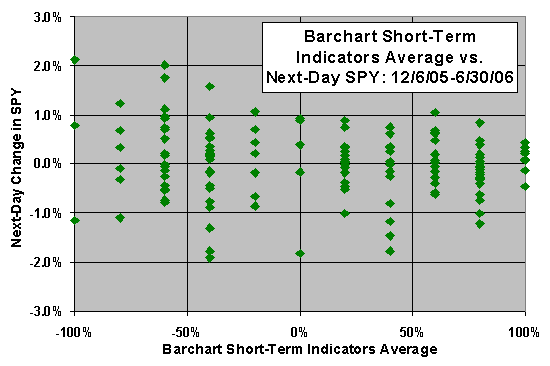
The following table summarizes a simpler counting analysis, showing the number of next-day ups and downs for SPY according to whether the Barchart.com Short Term Indicators Average is positive, neutral or negative during 12/5/05 through 6/30/06. Based on this sample, the Short Term Indicators Average seems ineffective for daily forecasting, perhaps contrarian for negative readings.

Barchart.com Overall Average vs. Next-Day SPY: The next plot correlates the Barchart.com Overall Average from each day’s close with the return for SPY the next trading day. Visually, it appears that there is a slight tendency for the daily return to fall as the Overall Average rises. The Pearson correlation for these two series is -.13, weakly supporting this observation. The sample size is a moderately large 143 observations, but the Overall Average is not independent from day to day, so additional data could modify these results.
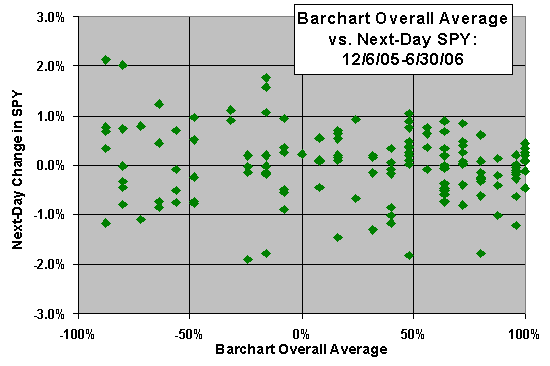
The following table summarizes a simpler counting analysis, showing the number of next-day ups and downs for SPY according to whether the Barchart.com Overall Average is positive or negative during 12/5/05 through 6/30/06. This result does not confirm the negative correlation determined above; the Overall Average is unreliable as a predictor for the next trading day.

Barchart.com Composite Indicator (Trend Spotter) vs. Next-Day SPY: The next plot correlates the Barchart.com Composite Indicator from each day’s close with the return for SPY the next trading day. On this plot, -100% = Sell, 0% = Hold and 100% = Buy. Visually, it appears that there is a tendency for the daily return to fall as the Composite Indicator rises. The Pearson correlation for these two series is -.13, weakly supporting this observation. The sample size is a moderately large 143 observations, but the Composite Indicator is probably not independent from day to day, so additional data could modify these results.
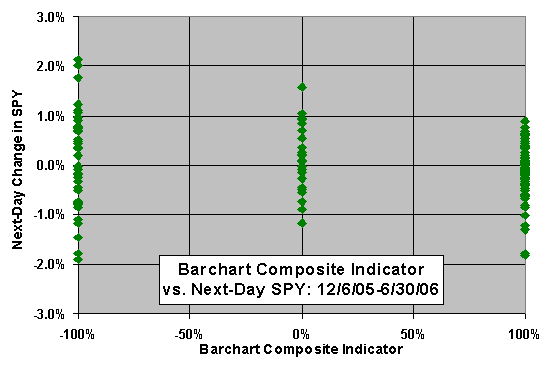
The following table summarizes a simpler counting analysis, showing the number of next-day ups and downs for SPY according to whether the Barchart.com Composite Indicator advises Buy, Hold or Sell during 12/5/05 through 6/30/06. This result does not confirm the negative correlation determined above; the Composite Indicator appears to be a random indicator for the next trading day.

Barchart.com Short-Term Indicators Average vs. 5-Day SPY: The next plot correlates the Barchart.com Short Term Indicators Average from each day’s close with the return for SPY over the next five trading days. Visually, it appears that there is a significant tendency for the 5-day return to fall as the Short Term Indicators Average rises. The Pearson correlation for these two series is -.31, modestly supporting this observation. The sample size is 139 observations, but the two parameters involved are each not independent from day to day, so additional data might change these results.
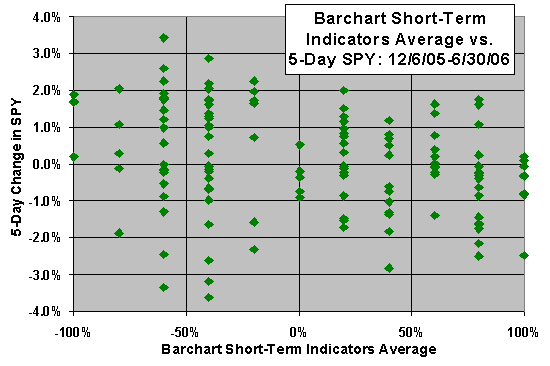
The following table summarizes a simpler counting analysis, showing the number times SPY is up or down over the next five trading days when the Barchart.com Short Term Indicators Average is positive, neutral or negative during 12/5/05 through 6/23/06. Based on this sample, the Short Term Indicators Average appears to be a contrarian indicator for the next five trading days.

Barchart.com Overall Average vs. 5-Day SPY: The next plot correlates the Barchart.com Overall Average from each day’s close with the return for SPY over the next five trading days. Visually, it appears that there is a tendency for the 5-day return to fall as the Overall Average rises. The Pearson correlation for these two series is -.29, modestly supporting this observation. The sample size is a moderately large 139 observations, but the two parameters involved are each not independent from day to day, so additional data might change these results.
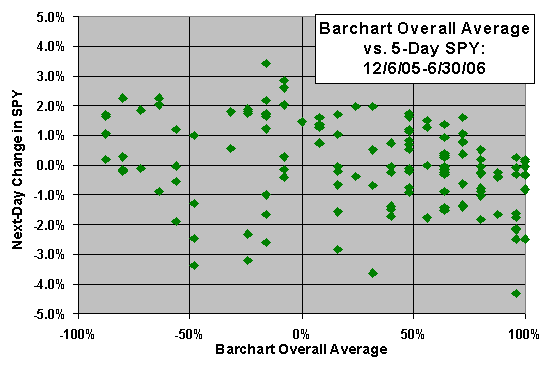
The following table summarizes a simpler counting analysis, showing the number times SPY is up or down over the next five trading days when the Barchart.com Overall Average is positive or negative during 12/5/05 through 6/23/06. Based on this sample, the Overall Average appears to be a contrarian indicator for the next five trading days.

Barchart.com Intermediate-Term Indicators Average vs. 5-Day SPY: The final plot correlates the Barchart.com Intermediate-Term Indicators Average from each day’s close with the return for SPY over the next five trading days. Visually, it appears that there is a tendency for the 5-day return to fall as the Intermediate-Term Indicators Average rises. The Pearson correlation for these two series is -.27, modestly supporting this observation. The sample size is a moderately large 139 observations, but the two parameters involved are each not independent from day to day, so additional data might change these results.
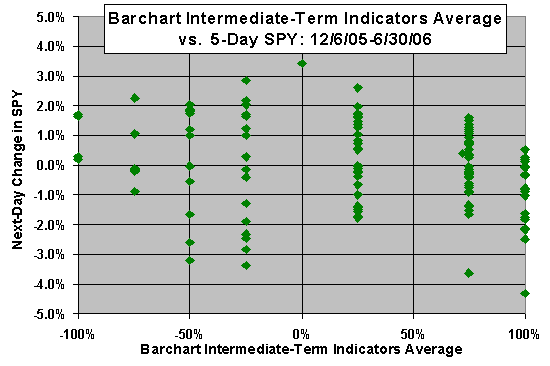
The following table summarizes a simpler counting analysis, showing the number times SPY is up or down over the next five trading days when the Barchart.com Intermediate-Term Indicators Average is positive, neutral or negative during 12/5/05 through 6/23/06. Based on this sample, the Intermediate-Term Indicators Average appears to be a contrarian indicator for the next five trading days.

In summary, Barchart.com generally leans a little the wrong way with respect to near term aggregate stock market action. This tendency is probably too weak to be tradable. Its indicators appear to overweight (underweight) the trend-following (reversal) nature of the market.